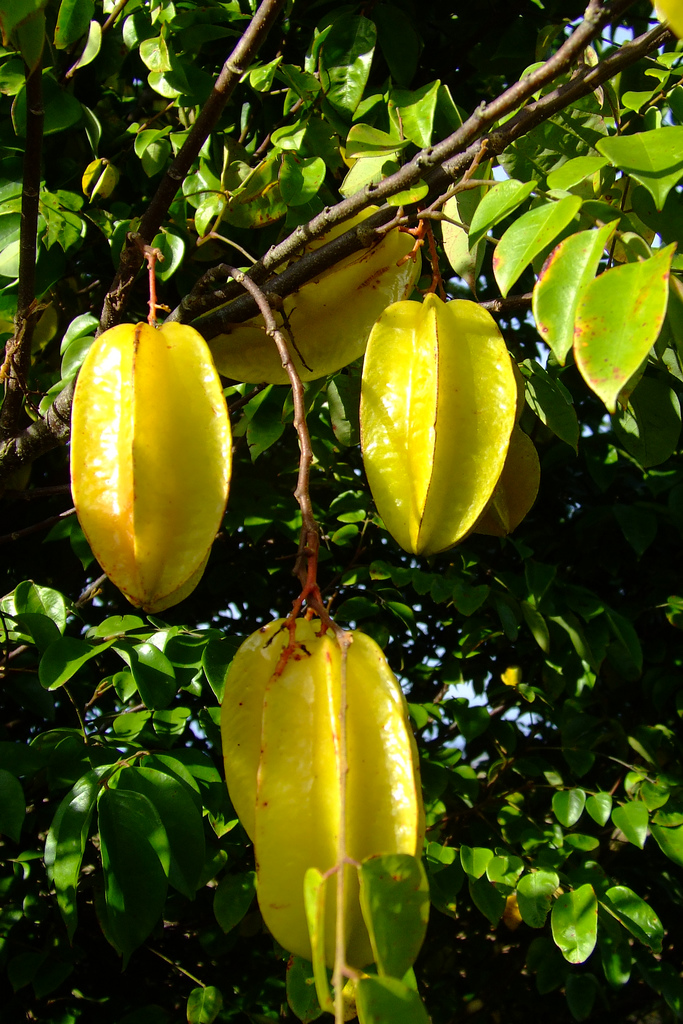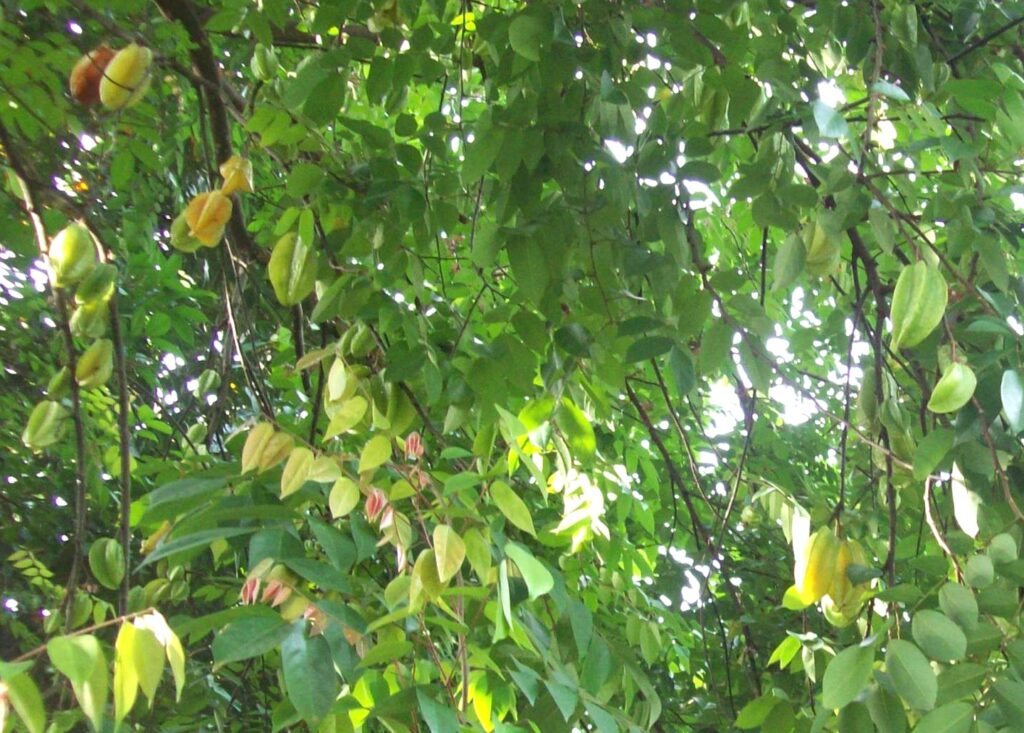Text and Photos by Henrylito D. Tacio
In Philippine politics, a person who is a turncoat or has many faces is called “balimbing.” The term originated from the stunning fruit whose shape has five angles or points. If you slice the fruit, however, a cross-section looks like a star, which is why it is sometimes called the starfruit.
In English-speaking countries like the United States, it is called carambola. In India (where it is native), the fruit is called kamranga or kamrakh. The Chinese are said to call the fruit yongl’o or foreign patch. In Vietnam, it is called khe, khe ta, or similar terms; in Kampuchea, spu; in Laos, nak fuang; in Thailand, ma fueang. Scientifically, it is called Averrhoa carambola.
“The Chinese and the Hindus eat the carambola when green as a vegetable, when ripe as a dessert,” writes Wilson Popenoe, author of Manual of Tropical and Subtropical Fruits. The author puts balimbing under “miscellaneous fruits” along with durian, santol, and tamarind.
W.F. Safford describes star fruit in these words: “It contains a clear watery pulp: astringent when green and tasting like sorrel or green gooseberries, but pleasantly acid when ripe, or even sweet, with an agreeable fruity flavor, and a strong perfume like that of the quince.”
It is best to consume balimbing when ripe. An unripe fruit will appear green, while a ripe balimbing will display colors of bright yellow with a light shade of green. It will also have brown ridges at the five edges and feel firm. An overripe fruit will be yellow with brown spots. The fruit is entirely edible, including the slightly waxy skin. It is sweet without being overwhelming and extremely juicy. The taste is difficult to compare, but some scribes have likened it to “a mix of papaya, orange, and grapefruit altogether.”
Balimbing reportedly contains approximately 36 calories per 100 grams. “The fruit, when fully ripe, are eaten out of hand, or they may be stewed,” Popenoe writes. “When slightly unripe, they are used for jelly and pickles.” It is also used as a garnish on avocado or seafood.
Balimbing has many health benefits, according to the website of Nutrition and You. “The fruit along with its waxy peel provides a good amount of dietary fiber,” it says. “Fiber helps prevent absorption of dietary LDL cholesterol in the gut. The dietary fibers also help protect the mucous membrane of the colon from exposure to toxic substances by binding to cancer-causing chemicals in the colon.”
Balimbing also contains good quantities of vitamin-C. Vitamin C is a powerful natural antioxidant. The website says 100 grams of fresh fruit provides 34.7 milligrams or 57% of daily required levels of vitamin C. In general, consumption of fruits rich in vitamin C helps the human body develop resistance against infectious agents and scavenge harmful, pro-inflammatory free radicals from the body.
Likewise, balimbing is rich in antioxidant phytonutrient polyphenolic flavonoids. Some of the important flavonoids are quercetin, epicatechin, and gallic acid. The website says the total polyphenol contents in balimbing are143 milligrams per 100 grams. These compounds help protect from deleterious effects of oxygen-derived free radicals by warding them off the body.
In addition, the fruit is a good source of B-complex vitamins such as folates, riboflavin, and pyridoxine (vitamin B-6). Together, these vitamins help as co-factors for enzymes in metabolism as well as in various synthetic functions inside the body.
Balimbing also contains a small amount of minerals and electrolytes like potassium, phosphorus, zinc, and iron. Potassium is an important component of cell and body fluids that helps controlling heart rate and blood pressure; thus, it counters bad influences of sodium.
Balimbing is touted to be a potent inhibitor. Some studies show that the consumption of balimbing fruit or its juice in combination with certain medications can significantly increase their effective dosage within the body.
But there are also health risks when eating balimbing. Like grapefruit, balimbing contains oxalic acid, which can be harmful to people suffering from kidney failure. Studies have shown that those who eat balimbing with kidney failure can experience hiccups, vomiting, nausea, and mental confusion. In some instances, death may also result.
Not all people can eat balimbing, though. “Starfruit contains oxalic acid, which can be harmful to individuals suffering from kidney failure, kidney stones, or those under kidney dialysis treatment,” healthtips.com warned. “Consumption by those with kidney failure can produce hiccups, vomiting, nausea, and mental confusion. Fatal outcomes have been documented in some patients. Anyone who experiences hiccups, vomiting or other unusual symptoms after eating starfruit should seek medical attention as soon as possible.”
Aside from the aforementioned health benefits, balimbing has other uses. It can also be cooked in puddings, tarts, and curries—the Chinese cook balimbing with fish. Thais boil the sliced green fruit with shrimp. In Queensland, Australia, the sweeter type is cooked green as a vegetable.
Cross-sections of balimbing may be covered with honey, allowed to stand overnight, and then cooked briefly and put into sterilized jars. Some cooks add raisins to give the product more character. A relish may be made of chopped unripe fruits combined with horseradish, celery, vinegar, seasonings, and spices.
In the United States, balimbing has diverse uses. Because of its attractive appearance, many Americans like to use the fruit as a decorative piece in their home or as an edible adornment to buffet and luncheon platters.
The juice squeezed from the fruits is served as a cooling beverage. In Hawaii, the juice of sour fruits is mixed with gelatin, sugar, lemon juice, and boiling water to make sherbet. In the Philippines, people often use the juice as a seasoning. The juice is bottled in India.
To make jelly, it is necessary to use unripe “sweet” types or ripe sour types and to add commercial pectin or some other fruit rich in pectins such as green papaya, together with lemon or lime juice.
Julia F. Morton, the author of Fruits of Warm Climates, reported that the flowers are added to salad in Java, Indonesia, while in India, they are made into preserves.
As balimbing contains potassium oxalate, the unripe fruit is used in dyeing and to remove iron-rust. In southern China, balimbings are preserved in a tin and exported to other countries. In the Philippines, the acid-type balimbing is occasionally used for cleaning and polishing metals.



